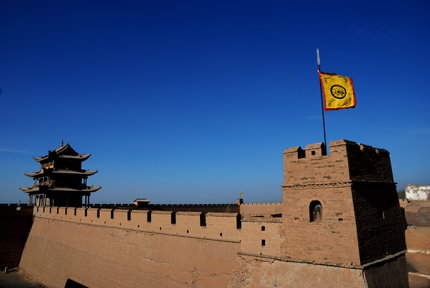
Gansu province, containing a key segment of the Silk Road, is an arid land of mystery, with temples, ruins, and the farthest western outpost of the Great Wall.
Apart from the famous Buddhist Mogao Grottoes in Dunhuang, Gansu is little explored and is the perfect place for hikers who seek adventure and little-known ancient history and culture. The land is a nexus of cultures.
The 1,000-kilometer River West Corridor, also known as the Gansu Corridor, connects cities including Dunhuang and Wuwei, all to the west of the Yellow River. It borders the Tibetan Plateau, Mongolia, the Inner Mongolia Autonomous Region, the Ningxia Hui Autonomous Region, the Xinjiang Uygur Autonomous Region, as well as the provinces of Qinghai, Sichuan and Shaanxi.
Though less famous than Xi'an City in Shaanxi province and Luoyang in Henan province, Gansu is home to the Four Towns in the West Corridor, referring to Dunhuang, Jiuquan, Zhangye and Wuwei. It's a place of surprising natural beauty.
Few people know that China's tourism logo, the Galloping Horse Treading on a Flying Swallow ("Ma Ta Fei Yan") is a 1,800-year-old bronze unearthed in Wuwei. China Post's symbol, the Postal Messenger, is taken from a design painted on a brick in a tomb near Jiayuguan. This town contains what is regarded as the far western extremity of the Great Wall. The Gansu Museum, one of the most important museums in China, is in Lanzhou, the provincial capital.
Besides the national treasures of the Mogao Grottoes in Dunhuang and Maijishan Grottoes in Tianshui (which Shanghai Daily has featured), Gansu contains other important, lesser known grottoes where seekers will be rewarded.
Tiantishan Grottoes near Wuwei is regarded as the original source of Buddhist sculpture art of Central China found in the grottoes of Yungang in Shanxi province and Longmen of Henan province. Bingling Temple in Yongjing is the only grotto in Gansu that bears clear year marks dating the Buddhist sculpture. It provides experts with tools and evidence to research the development and relationship among other grottoes in the region, including Mogao and Maijishan.
The roads from Lanzhou to Bingling and Wuwei to Tiantishan are beautiful and there are many photo opportunities along the way. There is an eight-kilometer section of unpaved roads on the way to Bingling Temple. It's best to hire a local driver/guide.
Gansu's location on the Silk Road and proximity to Tibet and other regions made it a natural place of exchange of trading goods, culture and art from as far away as India, Persia, Greece and Rome.
The province is preparing to apply to UNESCO for recognition of China's part of the Silk Road as a World Cultural Heritage.
Hua Pingning, director of the Maijishan Grottoes Research Institute in Tianshui City, was busy meeting with experts and artists from Beijing during Shanghai Daily's visit. Managers in Bingling plan to repave the roads in front of its gate to prepare for the application.
Visitors can expect more than archeological treasures in Gansu.
During a trip in April I explored the Confucian Temple in Wuwei on a snowy morning, and saw the peach and pear blossoms in Renshou Mountain in suburban Lanzhou. Tall cypress trees in Nanguo Temple in Tianshui are more than 2,500 years old.
Photography fans will savor western landscapes, deserts near Dunhuang, ancient walls in Jiayuguan, Tibetan-style stupas in Linxia, south of Lanzhou, and in Zhangye, the Danxia red cliff offering spectacular views at sunset.
Local food won't disappoint, since the area has what some consider the best lamb in China. A unique local wine made of broomcorn and rice is named after the most famous emperor in the Han Dynasty (202 BC-AD 220).
